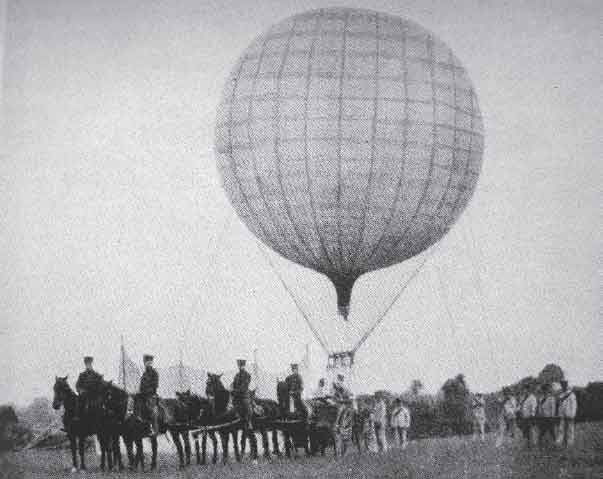From the 1850s to the 1890s
Family Background
Neville Florian Usborne was born on 27 February 1883, in Queenstown (now Cobh), in Co Cork, on the south-eastern coast of Ireland, the son of Captain George Usborne, RN, and his wife, Josephine Scott, whom he married in Queenstown in 1875 and who was the daughter of a wealthy local shipping merchant, Philip Scott (1808–1879) [Philip Scott’s father had founded James Scott and Co. of Cove in 1835. The family would be synonymous with shipping in Cork for more than 100 years. Philip, in his role as one of two town commissioners, presented the Address of Welcome to Queen Victoria and Prince Albert in 1849, and also requested the change of name from Cove to Queenstown. His son, James William, was a Cork Harbour Commissioner for forty years]. George was born in 1845 and entered the Royal Navy in 1860. He became a sublieutenant in 1865 and full lieutenant in 1867. He was appointed to the battleship HMS Zealous, a broadside armed, wooden hulled, ironclad, screw vessel serving as a flagship in the Pacific. In 1871 he was made flag-lieutenant in HMS Revenge (launched in 1859, a wooden hull, two-deck, second-rate of ninety-one guns, renamed Empress in 1890) at Queenstown, where it was the flagship of Rear Admiral Edmund Heathcote, the Port Admiral. George received a ‘haul-down’ promotion to commander in 1874. After studying at the Royal Naval College, Greenwich, he became Inspecting Officer of Coastguard at Moville, Co Donegal, in 1877 and later at Folkestone in Kent. It was there that he received the thanks of the German Emperor, together with a Berlin vase bearing the Emperor’s portrait, for his assistance during the loss of a German ironclad warship.
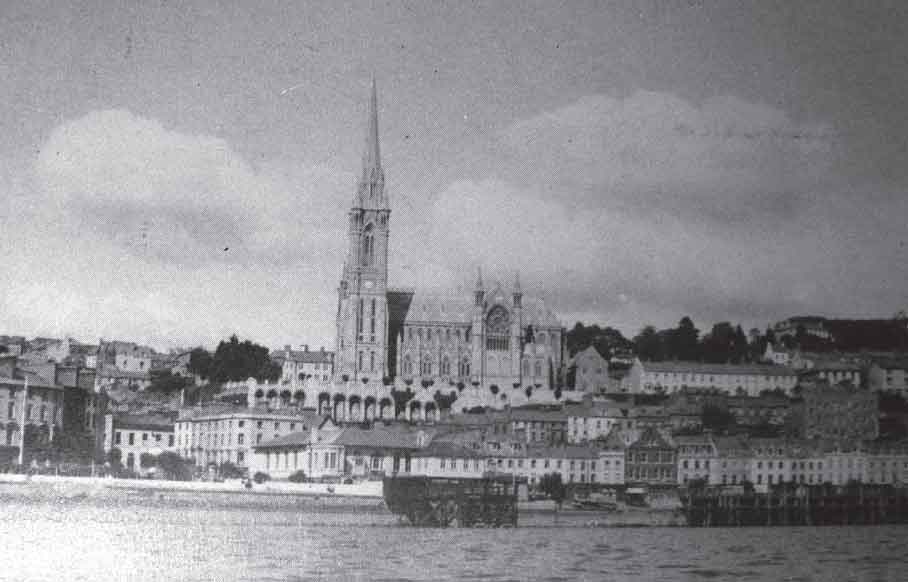
This view of the waterfront at Queenstown (now Cobh) is dominated by St Colman’s Cathedral, construction of which began in 1868. (Via Allen Crosbie)
Developments in Lighter-than-air aviation
As George approached his mid-30s there had already been several important developments in aviation during his lifetime. In July 1849, the Austrian steamship Vulcano had launched several hot-air balloons in an unsuccessful attempt to drop high explosive on the city of Venice, during the siege of the city.1 On 24 September 1852, the first manned flight in a mechanically-driven aircraft took place – 17 miles (27 km) at 6mph (9.6kph) – by the French engineer, Henri Giffard (1825–1882), who was also the inventor of the steam injector, in a 3hp (2.22kW) steam-powered dirigible – the engine, coke, boiler and water weighed 900lbs (408kg) – driving an airscrew with a diameter of 11 feet (3.35 metres). It was 144 feet (43.89 metres) in length, with a maximum diameter of 39 feet (11.84 metres) and had a capacity of 88,000 cubic feet (2500 cubic metres). The envelope, which was filled with coal-gas, was elongated, symmetrical, and with pointed ends. The car containing the engine and aeronaut was suspended some 20 feet (6 metres) below the gasbag, the stokehole of the boiler was screened with wire gauze, and the engine was inverted so that the exhaust products were directed away from the inflammable material above. He had been inspired and assisted with his design by the ideas and sketches of Lieutenant Jean-Baptiste Marie Meusnier of 1783 and Sir George Cayley in 1817.
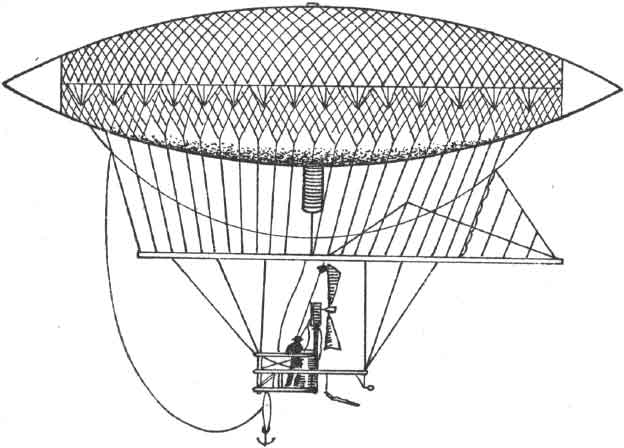
Giffard’s Airship, which made its historic flight in 1852.
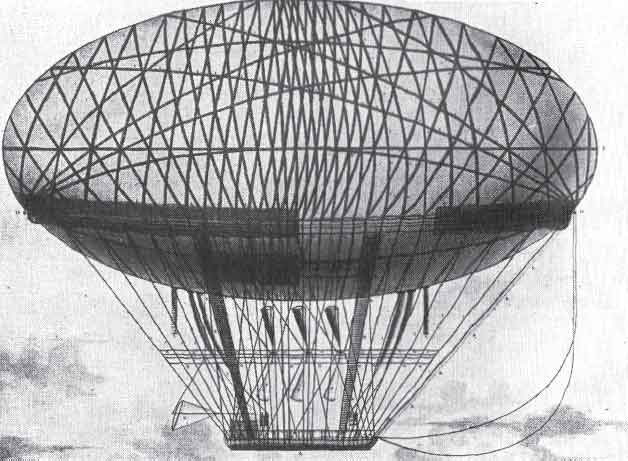
Meusnier’s design of 1784 for a dirigible was sound, he simply lacked a suitable source of motive power.

Cayley’s plans for a dirigible.
Meusnier’s design for a non-rigid airship anticipated many of the most important principles and featured ballonets (airbags mounted inside the gasbag to help keep it in shape and to maintain the internal pressure), rigging to suspend the car and an elongated shape – but he knew of no suitable power source. Cayley’s design was similar and planned to use a steam engine to drive propellers or moveable wings. Giffard described his experience thus:
‘I took off from the Hippodrome at a quarter past five. The wind was blowing fairly strongly. Not for a single moment did I dream of struggling directly against the wind, the power of the engine would not have permitted it; that had been thought of in advance and proved by calculations; but I carried out various manoeuvres of circular and lateral movement, successfully. The influence of the rudder could be felt immediately and I hardly had to pull lightly on one of the two steering lines before I saw the horizon move around me.’2
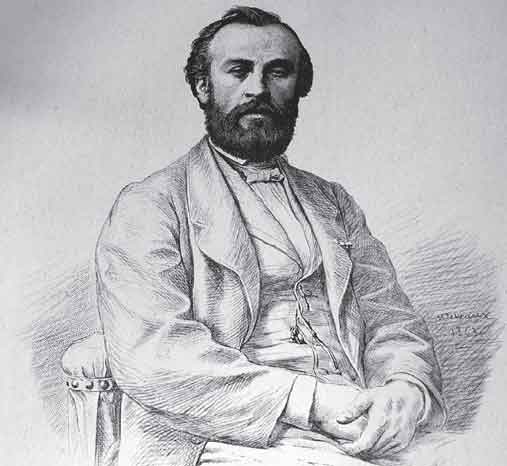
Henri Giffard.
After rising to 6000 feet (1828 metres), and as night was approaching, he extinguished the firebox, vented off the steam and landed successfully at Elancourt, near Trappes.
Just a few years later, the earliest known aerial photographs were taken over Paris in 1858 by Nadar, whose real name was Felix Tournachon (1820–1910). The Franco-Italian War of 1859 heralded the return of military ballooning by French forces after a gap of more than half a century3, with a short series of reconnaissance flights in hot-air balloons by the French aeronaut Eugène Godard (1827–1890) during the Battle of Solferino. The event was reported upon by many European newspapers, including the Irish Times:
‘Having first mounted on the campanile to take the bearings and make himself somewhat acquainted with the country, he entered his little skiff and went up in the air with a regularity which, according to those who saw the ascent, showed that he was master of his eccentric conveyance.’4
The First American Army Balloon Corps was formed on 1 October 1861, with five balloons and sixty men. Between 1861 and 1863 at least ten balloons were used for observation in the American Civil War, including the Atlantic, Saratoga, Enterprise, Intrepid, Washington, Union, Excelsior, United States, Eagle and Constitution. Balloons were present at the battles of Manassas, Bull Run, Fair Oaks, Chancellorsville, Seven Pines and Fredericksburg, where they were particularly of use in directing artillery fire. The first telegraph message to be transmitted from a balloon was sent by the American aeronaut Thaddeus Lowe (1832–1913)5 from the balloon Enterprise on 18 June 1861. A prominent Union officer, Major General William Farrar “Baldy” Smith, later noted, ‘the signals from the balloon have enabled my gunners to hit, with a fine degree of accuracy, an unseen and dispersed target area.’6 Then, on 3 August, John La Mountain (1830–1878) ascended in a captive balloon from the deck of the gunboat Fanny, to observe Confederate positions on the shores of Hampton Roads.7
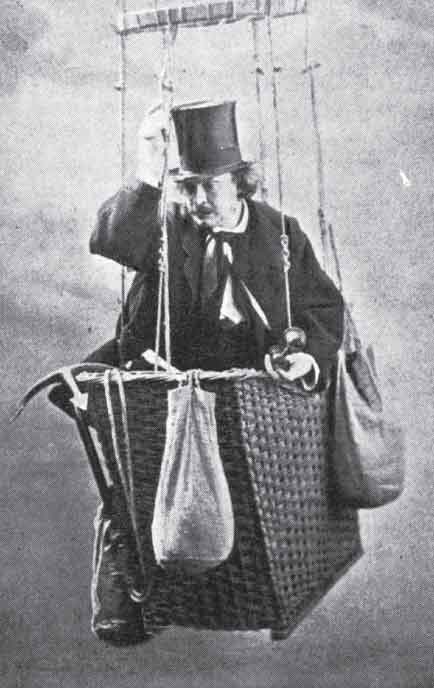
A very obviously staged photograph of Nadar.

The French aeronaut Eugene Godard.

Lowe ascends at Fair Oaks on 31 May 1862.
At the Battle of Richmond, in June 1862, it was reported in the Irish Times8 that the Federal forces sent up a balloon which supplied General McClellan with information by telegraph. It was discovered that even from a height of 200 feet (61 metres), an observer with a good telescope could spy on enemy activity as much as five miles (eight kilometres) away. Attempts were also made with regard to aerial photography. A converted coal barge, the George Washington Parke Custis, was used to convey and also tow balloons along the Potomac River, and may be termed the first operational aircraft carrier, or more accurately, ‘the first surface vessel to be specifically configured for the operation of an aerial device.’9 The greatest drawback was the requirement of heavy equipment needed to generate gas on-site, which was time consuming and cumbersome. The famous rigid airship constructor, Count Ferdinand von Zeppelin (1838–1917), there as a Prussian military observer, made his first ascent in August 1863 at St Paul, Minnesota. The Confederacy had also attempted to release a reconnaissance balloon from the steamship Teaser on the James River in 1862. Legend has it that it was manufactured from silk dresses patriotically donated by southern belles, but the true story is much more prosaic and it was actually made from raw silk at Savannah, Georgia.10
In 1870–71, during the Siege of Paris, balloons made sixty-six flights, carrying 164 passengers, 381 carrier pigeons, five dogs, three million letters and other cargo over the encircling Prussian Army between September 1870 and January 1871.11 The letters were written on rice paper to save weight and included communications from the author’s great-grandfather’s Paris office. The Irish Times Military Correspondent sent ‘Balloon News’ from Paris by means of telegraph from Rouen, describing combat under the walls of the city which had happened only a few days before. Five of the balloons were captured by the Prussians and two were lost at sea. Three captive balloon stations were also established in the city, from which ascents for the purpose of reconnaissance were made. The French statesman and future Prime Minister, Léon Gambetta, escaped from Paris in a balloon on 7 October 1871.
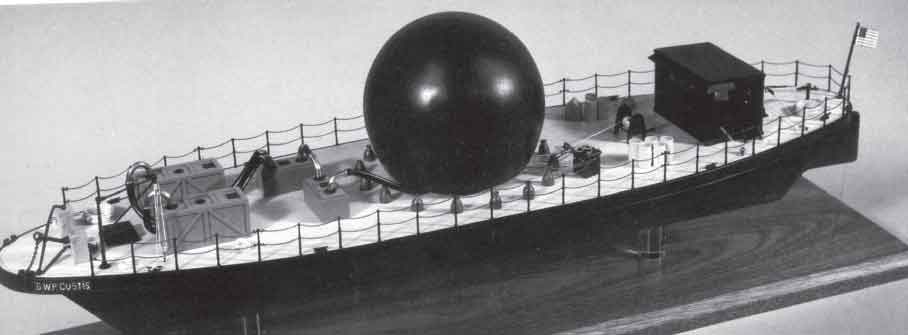
A model of the George Washington Parke Custis. (Mariners Museum, Newport News)
The Prussian Army also formed two Luftschiffer detachments with the advice and direction of the English balloonist, Henry Coxwell, but these were soon disbanded. Some years earlier, Coxwell had demonstrated to German officers in Berlin the practicability of dropping bombs from a balloon.12 Indeed, he maintained his interest in military ballooning right to the end of his long life, as not long before he died, on 5 January 1900, at the age of eighty, one of his last letters to the press was on the subject of the use of balloons in the Boer War.13
Perhaps inspired by the Parisian airmail, in March 1874, the German Postmaster General, Heinrich von Stephan, and founder of the World Postal Union, wrote a prophetic article on ‘World Postal Service and Airship Travel’ in which he stated:
‘Providence has surrounded the entire world with navigable air. This vast ocean still lies empty and wasted today, and is not yet used for human transportation.’14
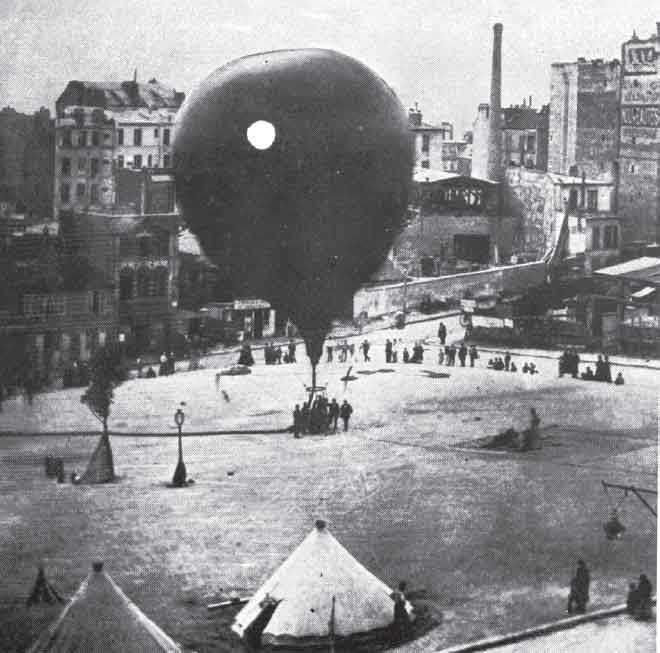
The Balloon Neptune during the Siege of Paris.
Count von Zeppelin read this and afterwards was inspired to make some notes in his diary:
‘Thoughts about an airship. The craft would have to compare in dimensions with a large ship. The gas volume so calculated that the weight of the craft would be supported except for a slight excess. The ascent will then take place through forward motion of the machine, which will force the craft, so to speak, against the upward inclined planes. The gas compartments will be divided into cells which can be filled and emptied individually.’15
Thoughts were also turning to a more organised military use of the air in France, with the formation of L’Éstablissement Central de Aérostation Militaire, at Meudon, to the south-west of Paris. Its first director was Captain Charles Renard, who would, within a few years, make airship history. Another French officer with an interest in aeronautics, Captain F. Ferber, summed up the challenge well: ‘To design a flying machine is nothing; to build one is nothing much; to try it in the air is everything.’16
First Steps in England
During these years the British Army, or at least a few technically minded officers, had become more aware of the benefits of ‘airmindedness’. In the 1850s, Henry Coxwell tried to interest the authorities in using balloons in the Crimea and elsewhere. Apart from some discussion and swift rejection of the topic of military ballooning by a War Office committee in 1854, it was not considered seriously until 1862. Lieutenant George Grover, RE,17 wrote two well-argued papers on the military use of balloons, which were published in the professional journal of the Royal Engineers. He firstly posed the question:
‘Are balloons capable of rendering sufficient service to an army, engaged in active operations, to make it worthwhile to authorise their employment as one of the resources of modern warfare?’18
He analysed the possible uses of balloons and rapidly dismissed the notions of either dropping explosive devices on enemy-held positions, or of transporting supplies into a besieged fortress or town, because no means of steering or motive power had been devised. He regarded the potential for, ‘assisting reconnoitring officers’ as having much greater potential, even from an elevation of a few hundred feet. He contended that they had not been employed by the British Army because of an overestimate of the problems involved and a lack of appreciation of the advantages. He listed the perceived problems as – vulnerability to ground fire, difficulty of transportation to a suitable operational site, adequate provision of gas in the field, the training of sufficient aeronauts and the general belief that ballooning was dangerous. He dealt with all of these in turn and answered all the points at issue very lucidly and clearly, coming to the following conclusion:
‘The subject is certainly worthy of the consideration of the Scientific Corps of the English [sic] Army, more particularly in the present day, when the resources of science are so especially directed towards the attainment of success in all military operations.’19
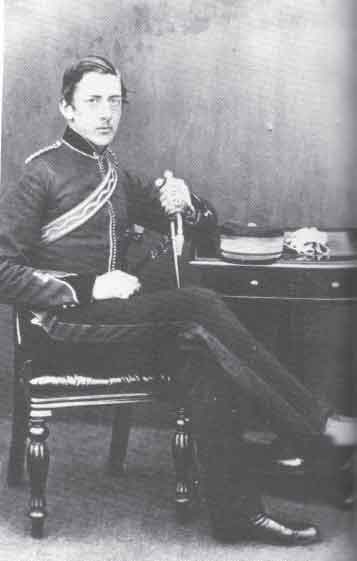
George Edward Grover of the Royal Engineers was an early advocate of Air Power.
Captain Frederick Beaumont, RE,20 who had observed the use of balloons by the Federal forces in the American Civil War, also wrote a paper for the same journal in which he described the equipment used by the Union Army in some detail. His conclusions were as follows:
‘I shall finish with a few remarks on the apparatus I would recommend for experimental purposes. Though for actual use, I think the larger sized balloon the best; a capacity of 13,000 cubic feet would give sufficient buoyancy for experiment. I would alter, however, the shape of the envelope, as the one commonly used is the worst that could be devised for the purpose [round or pear-shaped]; in the case of a free ascent, shape matters little, as the machine must go with the wind, but when the balloon is anchored it is of paramount importance to present the least possible surface to the action of the aft. I would, therefore, give to the balloon a cylindrical form, and to the car a boat shape, and I believe that with the decreased resistance offered, such stability might be obtained as to allow of ascents being made in weather that, with the old shape, would preclude their being thought of. I would also have the whole of the network and the guys of silk, for the sake of lightness. Comparatively speaking, the first cost would be unimportant, and with care they would last a long time, while, if it was thought desirable, common cord might be used for ordinary ascents, and the silk ones brought out only in case of great altitude being required. A very thin wire would enable telegraphic communications to be kept up, if necessary, with the ground, and an alphabetical instrument would place the means of doing so within anybody’s reach. The cost of an apparatus, perfect in every respect, would be about £500, and one for experimental purposes might be got up for much less. The officer in charge of it would require to have practical experience, but his assistants might be men taken from the ranks, and a few hours would make them sufficiently acquainted with their duties. The management of a balloon would seem to be a simple operation, and in perfectly calm weather when everything goes well, so it is; but to feel confident under adverse circumstances, and to know exactly what to do, and how to do it when difficulties arise, can be the result only of experience. It has been supposed that the swaying motion of a balloon when tied to the earth would occasion a nausea in some people akin to seasickness. I do not think this would be the case (with me it certainly was not so), as, if the notion were so great, fear would in all probability overcome any other feeling, and, at the same time under such circumstances, it would be useless to think of observing. I hope that the capabilities of balloons for military reconnaissances may receive a fair test, with properly prepared apparatus, as, should it be suddenly required to use them, it is quite possible that want of practice would turn what should have been a success into a failure, and the faults of the executive would be borne by the system. I am confident myself, that under certain circumstances, balloons would be found useful, and no one could say after all, more against them than that, like the fifth wheel to the coach, they were useless.’21
The following year, 1863, Grover and Beaumont, along with Henry Coxwell, ascended from the Queen’s Parade at Aldershot in the balloon Evening Star, which was inflated with coal-gas; later alighting in Milford, near Godalming in Surrey, where they were hospitably entertained by the local vicar. Ascents were also made from the grounds of the Royal Arsenal at Woolwich, which, after due consideration, the Ordnance Select Committee deemed to have sufficient promise to be allowed to continue as a series of trials. Investigations were made by the War Office Chemist, Professor Frederick Abel,22 concerning the generation of hydrogen and the most suitable material for balloon fabric. By 1865 it had been concluded that the expense did not justify further research at that stage, the committee being of the opinion that:
‘In special cases, particularly in siege operations connected with either attack or defence, balloon reconnaissance performed by experienced officers with powerful telescopic glasses would afford most useful information, but they are not prepared to recommend the special preparation of balloon equipment in times of profound peace.’23

Coxwell’s ascent in the balloon Mammoth from the grounds of Crystal Palace in September 1862.
However, following the successful use of balloons in the Franco-Prussian War in 1870–71, as described earlier, a sub-committee of the Royal Engineers Committee was formed (consisting of Abel, Beaumont and Grover) to have a further look at the possibilities. A gas furnace for the production of hydrogen was constructed at Woolwich Dockyard in 1873 and it was discovered that this method would be too cumbersome for use in the field. Lieutenant Charles Watson, RE, who replaced Beaumont, worked out a scheme for aerial support to be given to an expedition against the Ashanti, along with devising a portable gas apparatus which used sulphuric acid and zinc. This fell down on cost grounds. In 1875, the use of steel cylinders to transport gas was first proposed, but not developed further at that stage. Experiments with free and captive balloons were once more carried out at Woolwich Arsenal in 1878 under the command of Captain R.P. Lee, RE and Captain J.L.B. Templer, 2nd Middlesex Militia (later the 7th Battalion King’s Royal Rifle Corps), who had his own balloon, Crusader, filled by coal-gas. In fact, from 23 August 1878, Templer was even granted 10 shillings (50p) a day flying pay for services as an instructor – though only on actual flying days. The Times reported ascents made by Templer in Crusader and also the smaller balloon, Pioneer. It noted that Templer had lately been carrying out private experiments in Crusader, studying the prevailing winds to enable him to predict ‘very nearly’ the course his balloon would pursue, ‘which will probably be turned to advantage in future campaigns.’24 He was described as:
‘Tall, powerful, dark, of aspect stern and forbidding, not always popular with superiors by virtue of his disregard of regulations and impatience with official delays and obstructions, but a man who usually got his way.’25
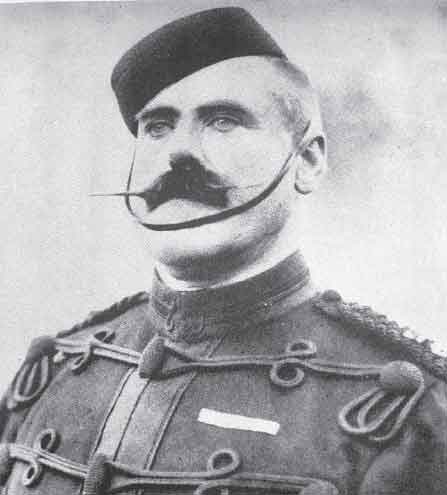
James Lethbride Brooke Templer.
It is also worthy of note that, as an officer in the militia, rather than being a regular, and in his early 30s, James Templer could devote more of his time to the rather esoteric subject of military ballooning instead of being forced to consider a career pattern in the Royal Engineers, which would have perforce demanded that he undertake a broader range of postings. The sum of £71 (from an initial allocation of £150) was spent on the balloon Pioneer – the envelope of which was made from specially treated and varnished cambric – which took to the air for the first time on the same day that Templer was awarded his flying pay. This compared very favourably with the £1200 suggested by Coxwell in 1873 as the price of a balloon for service in the Ashanti War. Pioneer was taken to the Easter Review of Volunteers at Dover by Templer and Captain Henry Elsdale, RE,26 in 1879, (in which year the unit was established as the Balloon Equipment Store) and to the Volunteers Field Day at Brighton in 1880. The balloon was filled from the nearest gas works. Elsdale sat in the basket while Templer travelled in the towing wagon. On 24 June 1880 came the earliest recorded use of a balloon detachment on manoeuvres at Aldershot, which was repeated in 1882. Experimental work was directed at the type of gas used, suitable fabric for the envelopes, improving the technique and practice of filling balloons and the whole question of transport. ‘A thoroughly sound and reliable fleet’27 of five balloons was established, including Sapper, Heron, Fly and Spy, with a few officers and men trained to use them. Heron’s envelope was made from goldbeaters skin, (an explanation of the manufacture of goldbeater’s skin will be found in Appendix 2) while Sapper’s was of silk treated with linseed oil; in the construction of the latter, Templer was assisted by Lieutenant J.E. Capper, RE, who had just completed the Army Engineering Course at Chatham and was awaiting a posting to India with the Bengal Sappers. He was recruited by Templer because of his mathematical ability, but his tough and forceful character impressed the older man.28 Capper himself later commented, ‘I was permitted to help, as even then I believed in the military future of balloons. We designed and made the first military balloon in England.’29 He will feature in this account again. In 1882 the store was moved to Chatham, and a small factory, depot and school of instruction were established there.
Meanwhile, Templer had experienced just how dangerous aerial activity could be; on 10 December 1881 he invited Walter Powell, the MP for Malmesbury, and James Agg-Gardner, the MP for Cheltenham, for a flight in the government-owned balloon Saladin. They departed Bath and headed towards Dorset:
‘Crewkerne was presently sighted, then Beaminster. The roar of the sea gave the next indication of the locality to which the balloon had drifted and the first hint of the possible perils of the voyage. A descent was now effected to within a few hundred feet of earth, and an endeavour was made to ascertain the exact position they had reached. The course taken by the balloon between Beaminster and the sea is not stated in Captain Templer’s letter. The wind, as far as we can gather, must have shifted, or different currents of air must have been found at the different altitudes. What Captain Templer says is that they coasted along to Symonsbury, passing, it would seem, in an easterly direction and keeping still very near to the earth. Soon after they had left Symonsbury, Captain Templer shouted to a man below to tell them how far they were from Bridport, and he received for answer that Bridport was about a mile off. The pace at which the balloon was moving had now increased to thirty-five miles an hour. The sea was dangerously close, and a few minutes in a southerly current of air would have been enough to carry them over it. They seem, however, to have been confident in their own powers of management. They threw out ballast, and rose to a height of 1500 feet, and thence came down again only just in time, touching the ground at a distance of about 150 yards from the cliff. The balloon here dragged for a few feet, and Captain Templer, who had been letting off the gas, rolled out of the car, still holding the valve line in his hand. This was the last chance of a safe escape for anybody. The balloon, with its weight lightened, went up about eight feet. Mr Agg-Gardner dropped out and broke his leg. Mr Powell now remained as the sole occupant of the car. Captain Templer, who still had hold of the rope, shouted to Mr Powell to come down the line. This he attempted to do, but in a few seconds, and before he could commence his perilous descent, the line was torn out of Captain Templer’s hands. All communication with the earth was cut off, and the balloon rose rapidly, taking Mr Powell with it in a south-easterly direction out to sea.’30
Despite extensive search operations by naval and commercial ships from England, France and the Channel Islands, Powell and the balloon were never seen again. No doubt George Usborne, in common with other educated and technically-minded citizens in Queenstown, would have kept abreast of these developments as reported in the English and Irish press.
Early Life in Queenstown
In 1880, George was appointed to the Queenstown Coastguard and served there for three years. Then, in December 1883, he joined Cork Harbour Board as Deputy Harbour Master, becoming Pilot Master in 1893 and eventually Harbour Master in 1922. He was Honorary Secretary of the lifeboat management committee for forty years. The May 1920 Lifeboat Journal reported that on:
‘20 April 1920, Admiral Sir Reginald Tupper, KCB, Commander-in-Chief Western Approaches, presented to Captain Usborne the Thanks of the Committee Management inscribed on Vellum, and the Silver Inkstand which had been awarded to him for his services during thirty-six years as Honorary Secretary of the Queenstown Station, which has now been closed.’
He retired from his position as harbour master in May 1925 owing to ill health and died two months later. His obituaries in the Irish press praised his long career of public service and noted that he had carried out his work with the Irish Times to his usual high standard, commenting favourably upon his, ‘utmost zeal and efficiency’, and the Cork Examiner recording that he was, ‘a very upright and kindly gentleman, who made innumerable friends amongst those who had the pleasure of his cultured and refined acquaintance’. George Usborne was very proud of his years of service in what he regarded as the safest harbour in the United Kingdom at all times. He recalled that he had seen the largest ocean steamers of nearly every line flying the British flag enter and leave the harbour at all stages of the tide, in all weathers, both day and night, and had never known a casualty occur, except through carelessness or some grave error of judgement.
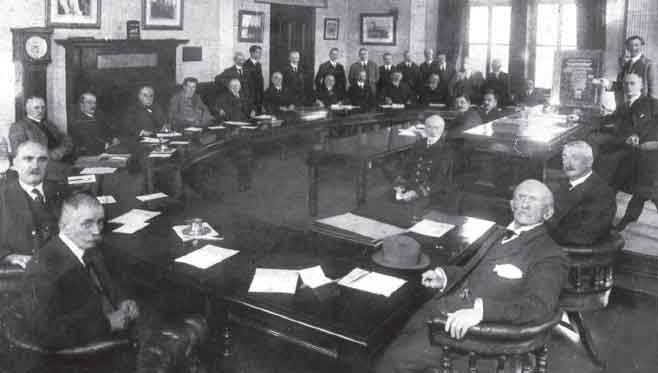
The Cork Harbour Board meets on 10 October 1917, Captain George Usborne is seated in the centre of the photograph, in uniform. (Port of Cork)

John Gilbert, Patrick’s Quay, Cork, 1886. Watercolour on paper 21 x 31cm. Crawford Art Gallery, Cork.
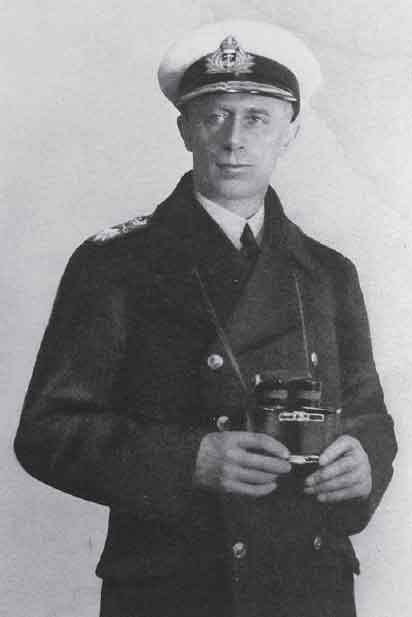
Rear Admiral C.V. Usborne.
Neville had two older brothers. Philip Osbert Gordon was born on 27 February 1879, in Folkestone. He was a Royal Engineer and later Director of Public Works in Uganda. He died in 1915 in Calcutta. Then there was Cecil Vivian, born on 17 May 1880, in Queenstown, who preceded Neville into the Royal Navy. He specialised in gunnery, and later in mine warfare, inventing the apparatus which led to the introduction of Paravane mine protection. During the Dardanelles campaign he took a flight to inspect the minefield laid in the narrow waters and was shot down by an over-enthusiastic British gunner – luckily without injury. He was promoted to captain in 1917; he was senior British officer at Salonika and later commanded the Naval Brigade on the Danube. He held a succession of staff appointments and important commands, including the battleships Malaya and Resolution after the war, and rose to the rank of vice admiral before he retired in 1933. He was recalled for service in World War Two and retired once more in 1945. Cecil died in January 1951. His obituary in The Times prompted a letter from a former companion in arms, who wrote as GOS and who praised the elder Usborne’s drive, persuasive manner, energy, ingenuity, sympathy and good administration.31
In the 1880s and 1890s, during the period when Neville and his brothers were growing up, Queenstown was prospering as never before or since. It was the terminus for the main railway line from Dublin. The transatlantic liners called, going and coming to deliver and pick up passengers and mail, and the harbour was full of sailing ships inward bound from China, India, Australia and New Zealand. Life for the professional classes in Queenstown in the 1880s and 1890s was more leisured and pleasant than at any time since. The children of such families were always privately educated. The Usborne family lived at Dunlea, and later at Carndonagh. Neville’s niece, Vivian Mary, later recalled:
‘I remember the sirens of the huge liners hooting as they left port, when, aged three or four, I went to stay in the house on the hill overlooking the harbour.’32
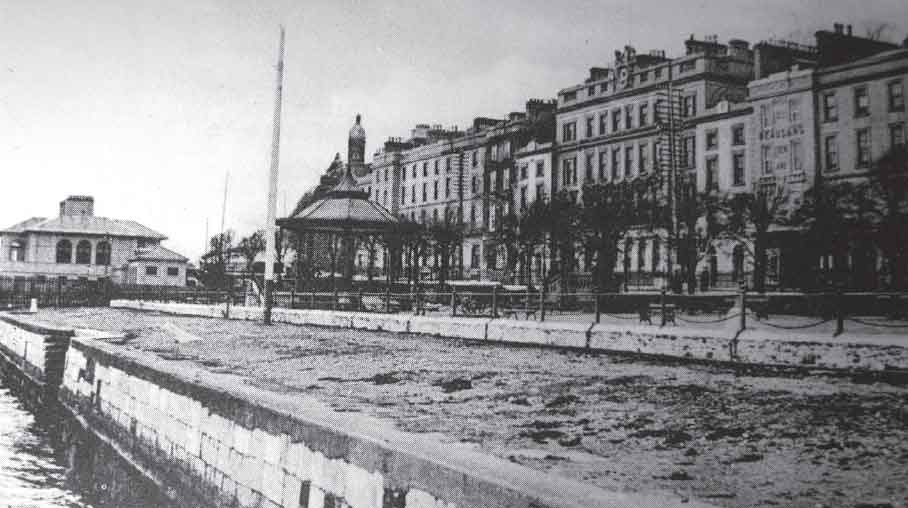
The Esplanade, Cobh, formerly Queenstown. (via Allen Crosbie)
The Cork Opera House was flourishing, and provided both light (Gilbert and Sullivan) and classical operas, and symphony orchestras came there for a season. Queenstown had its own Musical Hall. There was a pack of beagles on the island and major hunts on the mainland, and a lot of good shooting on the marshland round about. Only the wealthy would have possessed guns. Queenstown accommodated Cork businessmen, the families of the officers on the Royal Naval ships and the dockyard, and most of the families of the army officers stationed on Spike Island. The Admiral was the most important local dignitary.33
Developments in Naval Technology
The second half of the nineteenth century was also a time of great technological change with regard to warships, though technological progress was by no means welcomed by all. The great engineer, Isambard Kingdom Brunel, complained of the Admiralty’s attitude to innovation during the Crimean War in the following terms:
‘They have an extraordinary supply of cold water and capacious and heavy extinguishers…. But they have an unlimited supply of some negative principle which seems to absorb and eliminate everything that approaches them…. It is a curious and puzzling phenomenon, but in my experience it has always attended every contact with the Admiralty.’34
Steam propulsion in line-of-battle ships of the Royal Navy was introduced with HMS Sans Pareil in 1851 and the ninety-one gun HMS Agamemnon the following year (the first to be designed and built from the keel up with installed steam power). In 1860, HMS Warrior was launched, the first major warship to be built entirely of iron, which was followed by HMS Royal Sovereign in 1864, the first turret-armed battleship and the only one with a wooden hull. The Whitehead torpedo, which was invented in 1867, came to be regarded as a very great threat to the world’s navies, particularly after the development of small, fast, torpedo boats, which could potentially sink a more ponderous battleship; the first of these in RN service was HMS Lightning in 1877.
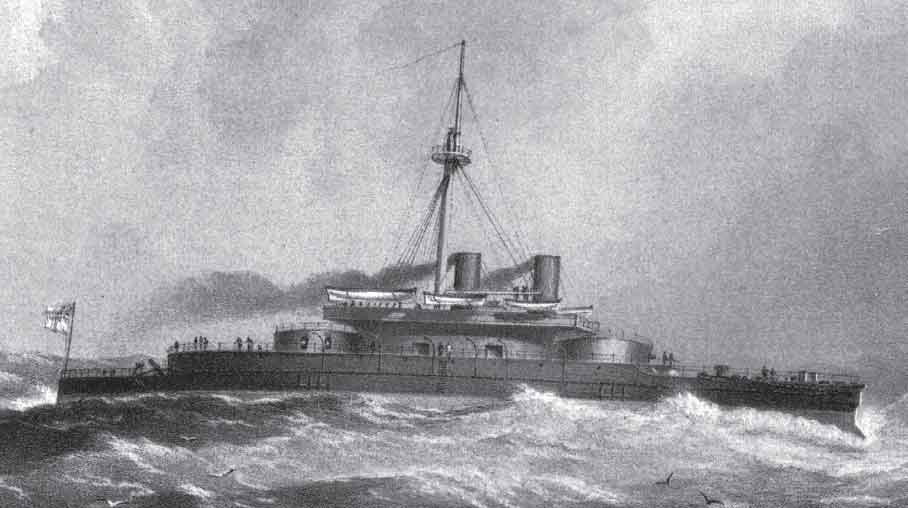
HMS Devastation.
In 1871, HMS Devastation created something of a sensation; it had no sails and relied solely on its 800 hp engine for propulsion; it had turrets fore and aft for a pair of muzzle-loading, rifled, 12-inch guns, which could train through 280 degrees – the main armament therefore being on top of the hull rather than within. The sailors were less than pleased with their accommodation, however, as when asked by a journalist what it was like below decks, the reply came that it was like living in, ‘rat holes with tinned air.’35 It is to be hoped that this was improved by the introduction of the first RN ironclad with electric lighting, HMS Inflexible of 1881.
Further Progress in the Air
While Neville was a babe in arms, a series of significant events in respect of lighter-than-air aviation took place in France. Firstly, in 1883–84, the Tissandier brothers, Gaston (1839–1906) and Albert (1843–1899), designed, built and flew the first dirigible powered by electricity. The envelope had a capacity of 37,400 cubic feet (1058 cubic metres) and was 92 feet (28 metres) long, with a maximum diameter of 30 feet (9.10 metres). The basket was fitted with a propeller and a small electric motor of less than 2 hp (1.48 kW) powered by a zinc-carbon battery. It made its first ascent from Auteuil, with the inventors on board, on 8 October 1883 and flew for about twenty minutes over the Bois de Bologne. A second ascent was made the following year, flying across Paris to Marolles-en-Brie.36 The Irish Times reported on the event:
‘Another interesting experiment in aerial navigation was tried on Friday by the brothers Gaston and Albert Tissandier; in shape their balloon resembles that of M. Giffard. The motive force is furnished by a Siemens dynamo which moves a screw. After leaving its moorings the balloon was carried by a strong west wind to the Seine, when its occupants set the screw in motion and caused it to remain almost stationary. It was then allowed to go with the current. After this it several times made headway against it. It was noticed that while the screw was working, the reporters, who followed in a carriage, could easily keep pace with it, but when the motion stopped and the wind was allowed to have its own way, they were immediately left far behind.’37
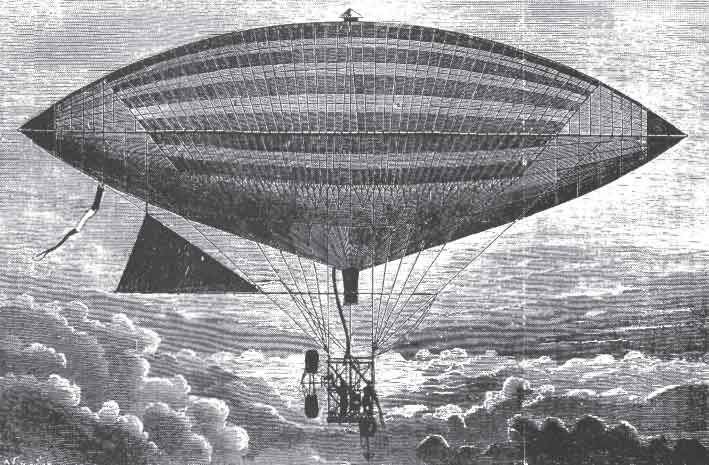
The Tissandier brothers’ airship.
On 8 August 1884, French Army Balloon Corps Captains, Charles Renard (1847–1905) and Arthur Krebs (1850–1935), took off from the French Army balloon establishment at Chalais-Meudon Park, in the electrically-powered (batteries and 8 hp (5.92 kW) electric motor) dirigible, La France, which had a capacity of 66,000 cubic feet (1868 cubic metres). It had a very large, two-bladed propeller at the front of the bamboo, canvas-covered car and at the rear, a rudder and an elevator. The envelope was 165 feet (50.29 metres) in length, had a maximum diameter of 27 feet 6 inches (8.38 metres) and was made from varnished Chinese silk. It was the first aircraft in history to return to its starting point against the wind, making a return trip of twenty-three minutes, covering 5 miles (8 km). The pilots described their trip as follows:
‘At four o’clock on a particularly calm afternoon the balloon, set free and having a very low ascensional force, rose up slowly to the height of the surrounding plateaux. The engine was put into motion and soon, under its impulse, the balloon increased its speed, faithfully obeying the slightest action of its rudder.’38

Charles Renard and Arthur Krebs.

La France at Chalais in 1884.
They steered for Villacoublay, and over the town executed a broad turn and proceeded back to Chalais at a height of about 1000 feet (304 metres). They commenced their descent above the landing field:
‘During this time we had to go backwards and forwards several times in order to keep the balloon over the landing point. At a height of 250 feet (76 metres) we dropped a rope, which was seized by men on the ground and the balloon was brought back to the same meadow from where it had left.’39
In the words of the correspondent writing for the Irish Times:
‘The apparatus is described as a balloon pointed at both ends like a whaleboat, and holding the usual supply of gas. Below is a net containing, in addition to the officer who attended the valve and the other who steered, certain electrical accumulators, which supplied a motor, employed to set in motion a screw propeller by which the balloon, so far as we can make out, is not only driven in space, but also to some extent guided in the same way that a ship is directed in its true course by means of a rudder.’40
Renard informed the press that his flight was just the start of a revolution, not only in aerostatics, but also in warfare, with armies being flown vast distances across trackless wastes to relieve beleaguered cities such as Khartoum – which was at that time much featured in the daily news and was eventually relieved (but not by air) in January 1885, just two days after the death of General Gordon. He also predicted aerial services for passengers and mails. Several further successful flights were made over the course of the following year.
Then, in 1885, Gottlieb Daimler produced the world’s first practical, petrol-driven, internal combustion engine, which could be developed as a power unit with a power to weight ratio suitable for propelling vehicles on land, sea and in the air. The original model had been invented eight years before by Nikolaus Otto. The year also brought the establishment of a permanent military balloon arm in Germany with the creation of the Preussische Luftschiffer-Abteilung at Berlin-Schöneberg. A few years later a Military School of Ballooning for the Bavarian Army was set up at Munich and a Balloon Corps was founded in Vienna.
Nor was the potential of military aviation ignored by the writers of popular fiction. In 1886, inspired by the feat of Renard and Krebs, the famed author of science fiction, Jules Verne, published The Clipper of the Clouds, which described the use of dirigibles as forces for good and evil. Another French author and illustrator, Albert Robida, wrote in 1887, La Guerre au Vingtième Siècle (War in the Twentieth Century), which foresaw a sudden devastating strike from the air by aerial torpedoes launched from aircraft powered by electricity.41
The Royal Engineers Balloon Section
Meanwhile, returning to the British Army’s aviation activities in June 1883, Major Lee, RE, and Lieutenant Francis Trollope, Grenadier Guards, were sent to Paris to visit the balloon exhibition and report on what they saw. Then, in September 1884, the centenary of ballooning in England was celebrated in the grounds of the Artillery Company, at Finsbury in London, by the ascent of several balloons and a lecture from M. de Fouville, President of the Academie de Aérostation, Paris. While this was going on the Royal Engineers were also developing their aeronautical skills by preparing for a deployment overseas. A significant development was the introduction, in 1884, of steel cylinders which could store hydrogen under compression and so transport supplies of the gas for use in the field. Balloons could now be inflated in ten or fifteen minutes. One of the most difficult problems to overcome was the design of a valve secure enough to prevent the leakage of hydrogen.42 A balloon section, with three balloons, Heron, Spy and Feo, ten NCOs and sappers, commanded by Major Elsdale, RE, with Lieutenant Trollope, accompanied a substantial army expedition under the command of Major General Sir Charles Warren, consisting of some 4000 infantry, cavalry, artillery and engineers, to Bechuanaland in November 1884. The aim was to assert British sovereignty and, ‘To deal with Boer raiders and to pacify the country.’43 A local chief, Montsiou, was taken up for a flight and observed:
‘If the first white man who came into this country had brought a thing like that and, having gone up in it before our eyes, had come down and demanded that we should worship and serve him, we should have done so. The English indeed have great power.’44
Sir Charles Warren was taken aloft in Heron in April 1885 at Mafeking and was impressed by the view of the surrounding countryside that could be obtained. It was discovered that the lifting capacity of the balloons was impaired the higher above sea level they operated. It was also noted that the conduct and ability of ground staff was vital to the success of aerial operations.45 Moreover, it was shown that a detachment of only ten men was too small for the effective working of the equipment.46
A Royal Engineers mobile balloon section.
Major Templer led a section of eight NCOs and men, as well as the three balloons, Scout, Fly and Sapper, which travelled to the Sudan (or the Soudan – as it was termed in the contemporary newspapers) in February 1885 (following the death of General Gordon at Khartoum) as part of the protection for a military railway construction project. The materials taken also included 120 cylinders of hydrogen, a compressor, searchlights, and signalling equipment. Camels were used to transport the gas cylinders. No doubt the heart of one of the expedition’s staff officers, Major George Grover, RE, was gladdened by this demonstration of this aeronautical progress, albeit some twenty years after he had first proposed it. One particularly noteworthy event occurred on 25 March, when Lieutenant R.J.H.L. Mackenzie, RE, remained aloft for seven hours in the balloon Scout during a route march, towed by a mule carriage in the convoy, with a further guide rope attached to a mounted horseman, messages to the ground being passed down via the latter:
‘When the convoy was ready to move, the balloon, still two hundred feet up, was made fast to a cart in the centre of the square. It was rather difficult to avoid jerking the cords which held it, and thus running the chance of breaking them; but extreme care was taken when crossing any rough pieces of ground, as it would not have been unpleasant for the occupant of the car if he had suddenly found himself floating quietly towards the mountains, miles beyond the reach of any friends. Communication was kept up with the balloon by means of written messages, and it was not long before a letter came down telling us that the enemy were still pursuing the stampeded camels down towards the sea and killing them as soon as they got up with them. The force reached the zaribas at last, unmolested, when the balloon was hauled down and packed up, the gas being as far as possible saved for future use. Thus the first ascent may be chronicled as a success.’47
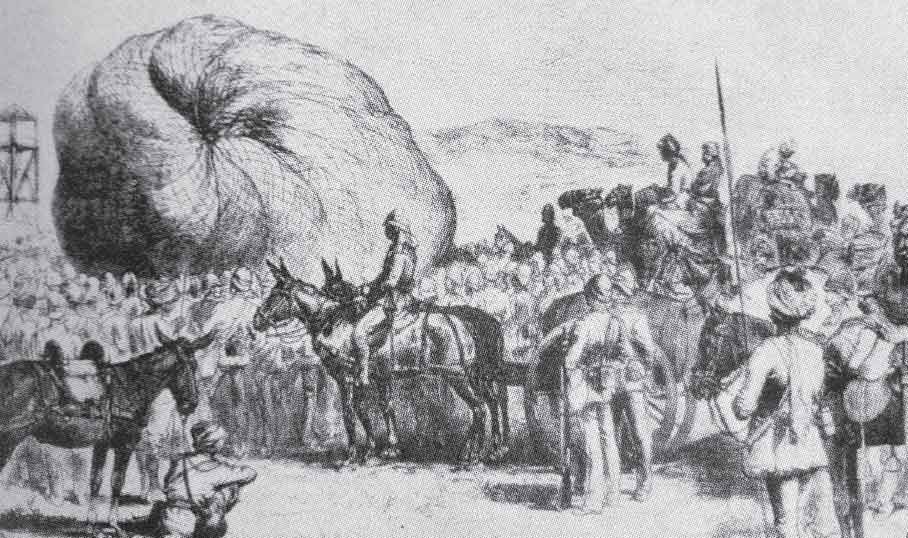
An artist’s impression of a military balloon being inflated in the Sudan in 1885.
Mackenzie was therefore the first British airman to carry out his ‘force protection’ duties in the presence of the enemy, namely the Mahdi’s Dervish warriors. The Irish Times reported that:
‘The convoy with the captive balloon were in no way molested, which can scarcely be wondered at if the rebels were as astonished by the strange spectacle as have been the natives of Suakin. The native gossips here are all agog at the startling phenomenon and the bazaars throughout the day have been in a perfect ferment upon the subject. Even now they have not apparently satisfied themselves as to the origin and uses of a war balloon.’48
However, the expedition’s senior Royal Engineer, Colonel Edwards, remarked:
‘The detachment deployed was numerically too weak for the duty and it is absolutely necessary that the men should be thoroughly drilled and instructed in handling the balloon in a moderate breeze. On 2 April we were obliged to supplement the detachment with men from the Royal Engineer companies, who had never worked a balloon before, consequently they were unable to keep it steady.’49
It was noted that the effect of the balloon on the morale of the enemy was such that the aerially escorted convoy was free from any attack, whereas the two previous ones had met with considerable opposition. On the following day, Scout accompanied a convoy of 1200 camels, escorted by the Berkshire Regiment; not a camel was lost. Fly later went further up-country and was used with success for reconnaissance. Templer was mentioned in dispatches for his actions during the expedition in the engagement at Hasheen. He also had an eye for the main chance. On his way back to England he noticed a couple of traction engines lying at Suakin, apparently ownerless. He decided that they would be a useful asset and laid claim to them by the simple but effective method of chalking, on the boilers of both, the address, ‘The School of Ballooning, Chatham’, to which they were shipped in due course, along with a fine marquee, which later saw much service as the RE Officers’ Mess when at balloon training camps.50
Back in England, experiments were made with artillery spotting, aerial photography and with towing the balloon wagons by the newly acquired traction engines. The experiences in the field in 1885 proved that a balloon detachment should be supported by at least thirty sappers to work the balloon properly. Detachments also took part in camps, one of which was at the artillery practice ground at Lydd in Kent, where members of the public often showed some interest, but rather less comprehension. An officer once spent some considerable time explaining military ballooning to a lady visitor; when he had finished she said that she thought she understood everything, but had one question, ‘How do you breathe inside?’51 Remarkably, much of the cost of maintaining the Balloon Establishment had been met by the enthusiastic and reasonably wealthy Templer, out of his own pocket. He bought some ground at Lidsing, a few miles from Chatham, where a pit was dug in the chalk of sufficient depth to take a large balloon and keep it completely secure from the wind. This anomalous financial arrangement was rectified by the War Office in 1887, when ballooning activity was split into two parts, the military flying side under Major Elsdale and a civilian manufacturing section under Templer, the whole being named the School of Ballooning. Templer was gazetted major and given a salary of £600 a year.
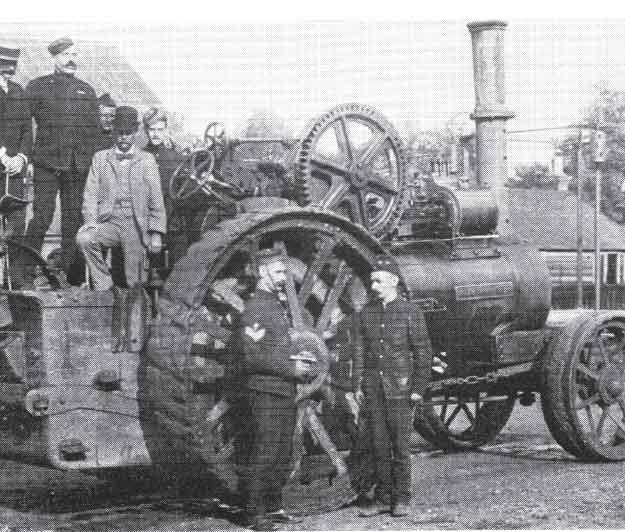
Major Templer (second left) stands proudly atop one of the traction engines which he had acquired.
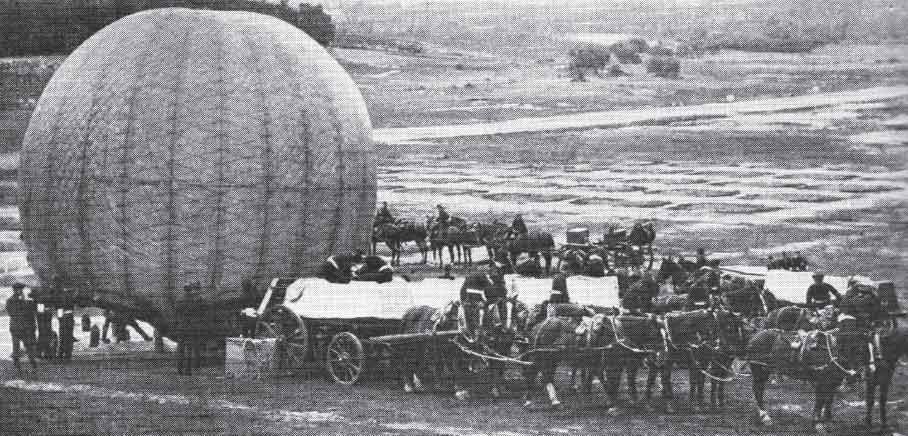
A Royal Engineers balloon being filled with hydrogen in the field.
The establishment was as follows:
1 Officer-in-Charge
1 Instructor in Ballooning
Balloon Detachment:
1 Lieutenant
1 Sergeant
15 Rank and file (corporals and below)
1 Military mechanist
1 Gas maker
1 Storeman
1 Driver
10 balloon-making hands (including women)
Specialist transport was to be provided, but without horses. These were to be drawn from the Army Service Corps along with general service wagons.52 A balloon train consisted of a balloon wagon with hauling down gear, three wagons to carry forty-four gas cylinders each, an equipment wagon with spare balloon envelopes and stores, and a water cart. All the wagons were fitted with draw bars so the entire train could be towed by a traction engine.53
A balloon flown by Lieutenant Bernard Ward, RE, took part in the Aldershot Summer Manoeuvres in 1889, receiving the approbation of Lieutenant General Sir Evelyn Wood, VC, after a successful night attack made on the basis of the aeronaut’s report. Sir Evelyn later remarked that it was likely that balloons would henceforward play an important part in military campaigns of the future. He also advocated that the Balloon Establishment should be relocated from Chatham to Aldershot.54 At a parade held in honour of the German Emperor, Ward ‘marched past’ at a height of 300 feet (91 metres), towed by a wagon.55
Naval Developments
Royal Naval matters were also progressing. The Naval Defence Act of 1889 gave naval architects the opportunity to concentrate on producing standard designs for different classes of ship as Lord Salisbury’s government provided sufficient funding (£21.5 million) to order ten battleships, nine first-class cruisers, twenty-nine second-class cruisers, four third-class cruisers and eighteen torpedo gunboats. Ships were to be designed around their weapons rather than have them fitted into the hull as an afterthought. A countermeasure to the torpedo boat was also conceived with the laying down of the first torpedo boat destroyer, HMS Havock, in 1893. The balance of advantage was again altered by the introduction of a gyroscopic control mechanism for torpedoes in 1896.
